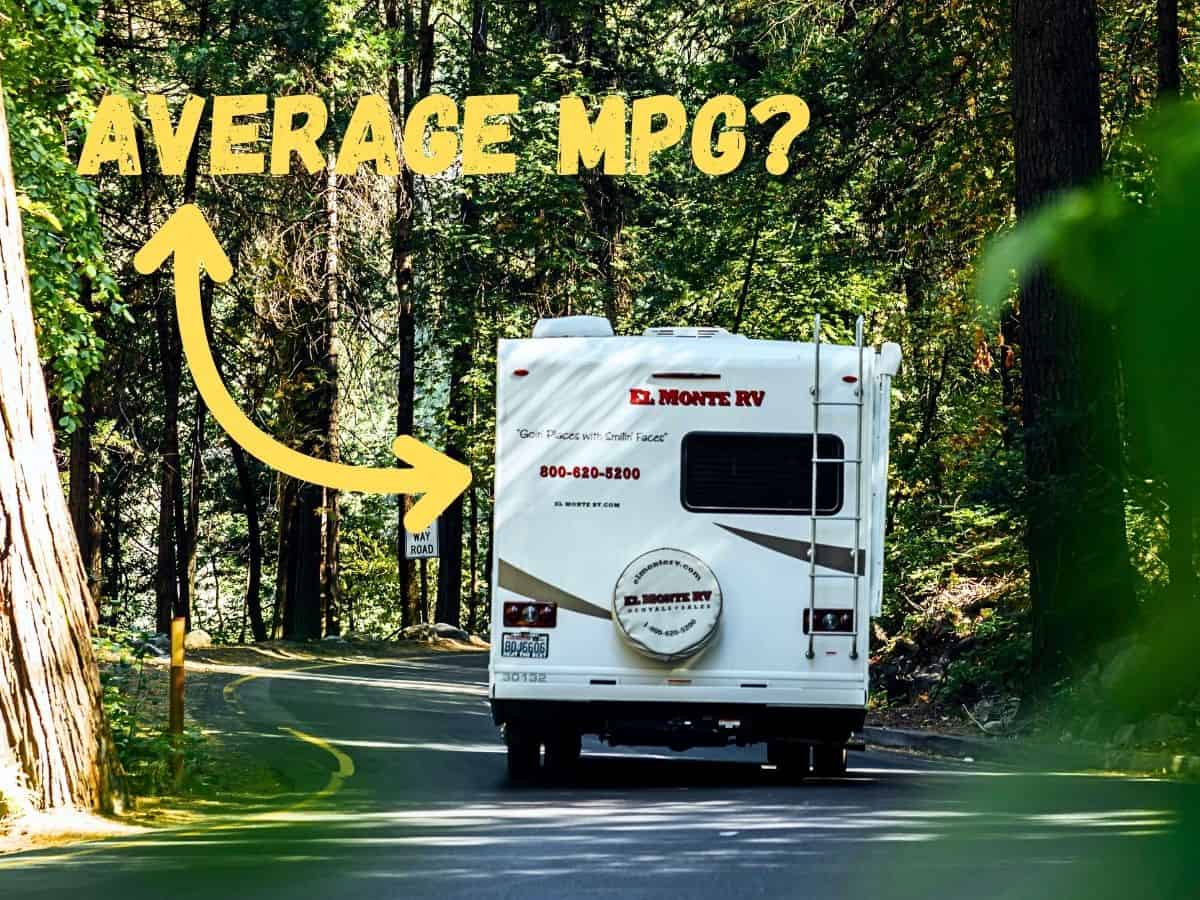Hitting the open road in a Class C motorhome is an adventure like no other, however, it’s important to understand Class C RV fuel mileage first, as this can help you choose the most fuel-efficient model that still meets your needs.
To help with this, we created this blog post, highlighting 15 different Class C motorhomes and their fuel economy.
Plus, we also discuss Class C fuel tank sizes and capacities, tips for improving fuel economy, and what the most fuel-efficient Class C RVs are.
Class C RV Fuel Mileage: Average MPG
Before providing examples of Class C RV fuel mileage, it’s important to define what a Class C RV is so that everyone is on the same page.
A Class C RV, also known as a Class C motorhome, is a driveable RV built on a cutaway truck or van chassis with an attached rear cab.
It’s important to note that this definition includes both larger Class C RVs built on Ford E-350 and E-450 chassis with cab-over-bunks, as well as smaller Class C RVs built on Ford Transits or RAM ProMasters that may or may not have a cab-over-bunk, often called Class B+ RVs.
Now that we’ve defined a Class C motorhome, let’s look at the average fuel economy of a Class C RV.
Class C RVs offer fuel mileages ranging from 8 to 18 miles per gallon (MPG), depending on vehicle size, weight, engine type, and driving conditions.
Let’s look at specific examples to better understand Class C RV fuel mileage.
15 Real-World Examples of Class C RV Fuel Mileage (Least to Most Efficient)
| Make/Model/Trim | Average MPG | Length | GVWR |
|---|---|---|---|
| 1. Winnebago Outlook 22C | 8 MPG | 24′ 2″ | 11,500 lbs |
| 2. Winnebago Minnie Winnie 22R | 8 MPG | 23′ 10″ | 11,500 lbs |
| 3. Forest River Sunseeker 2500TS | 8 MPG | 26′ 11″ | 14,500 lbs |
| 4. Nexus Triumph 32T | 8.5 MPG | 32′ 9″ | 14,500 lbs |
| 5. Jayco Redhawk 31F | 9 MPG | 32′ 6″ | 14,500 lbs |
| 6. Fleetwood TIOGA 26F | 10 MPG | 26′ 11″ | 14,050 lbs |
| 7. Gulf Stream BT Cruiser 5210 | 12.5 MPG | 22′ 6″ | 12,500 lbs |
| 8. Thor Motor Coach Gemini 24KB | 14 MPG | 25′ 10″ | 11,000 lbs |
| 9. Coachmen Crosstrail 20BH | 16 MPG | 24′ 2″ | 11,000 lbs |
| 10. Winnebago Ekko 22A | 16 MPG | 23′ | 11,000 lbs |
| 11. Coachmen Prism Select 24FS | 17 MPG | 25′ 2″ | 11,030 lbs |
| 12. Winnebago View 24D | 17 MPG | 25′ 6″ | 11,030 lbs |
| 13. Airstream Atlas 24MS | 17.5 MPG | 24′ 9″ | 12,125 lbs |
| 14. Entegra Qwest 24L | 18 MPG | 25′ 2″ | 11,030 lbs |
| 15. Dynamax Isata 3 24RW | 18 MPG | 24′ 7″ | 11,030 lbs |
Understanding Class C RV Fuel Mileage
Many factors can affect fuel mileage, which is why it’s so hard to give an exact number on Class C RV average miles per gallon.
So to help understand Class C mileage a little better, let’s look at the main facts that affect Class C RV MPGs.
Factors Affecting Class C RV Fuel Economy:
- Size and Weight: It probably comes as no surprise that larger, heavier Class C motorhomes generally consume more fuel.
- Towing: Beyond the size and weight of a motorhome, the next biggest impact on fuel economy is towing. Towing a vehicle or trailer behind a Class C RV can reduce fuel economy by 30 to 50 percent.
- Engine Type: Diesel engines generally provide better fuel efficiency than gasoline engines, especially on larger motorhomes.
- Aerodynamics: The boxy shape of most Class C RVs creates wind resistance, impacting fuel economy. Some newer models feature more streamlined designs to combat this.
- Driving Habits: Aggressive acceleration, hard braking, and speeding can all decrease fuel efficiency.
- Terrain: Hilly or mountainous routes will consume more fuel than flat highways.
- Load: The amount of gear, water, and passengers loaded into a Class C adds weight and decreases fuel economy.
- Maintenance: Regular tune-ups, proper tire inflation, and clean air filters can all contribute to better fuel economy.
Comparing Class C RV Fuel Economy to Other RV Classes:
When comparing Class C RV fuel economy to the other types of motorhomes, including Class B and Class A RVs, Class C motorhomes typically fall between these other two classes.
Class B RVs are generally the most fuel-efficient, thanks to the smaller size, reduced weight, and more aerodynamic shape. While Class A RVs are generally the least fuel-efficient, due to their larger size, heavier weight, and less aerodynamic shape.
For a general comparison here are the average MPGs for each major class of motorhome:
- Class B: 18-25 MPG
- Class C: 8-18 MPG
- Class A: 6-10 MPG
It’s important to note that these are general ranges, and individual models may perform better or worse.
Average Fuel Mileage for Class C Motorhomes:
As we touched on earlier, most Class C RV owners can expect to achieve between 8 and 18 MPG.
However, it’s important to set realistic expectations based on your specific model and how you plan to use it.
- Smallest Class C RVs (Class B+ Style): Can achieve 14-18 MPG under ideal conditions.
- Smallest Traditional Class C RVs (Under 25 Feet): Will usually top out at around 12 MPG.
- Mid-size Class C RVs (25-30 feet): Expect around 8-13 MPG.
- Larger Class C RVs (30+ feet): Typically fall in the 8-10 MPG range.
Remember, these figures can vary based on the RV load, the terrain, and driving habits.
Class C RV Fuel Tank Capacity

Understanding Class C RV fuel tank capacity is crucial for planning Summer RV road trips and managing your fuel budget effectively.
So let’s look at this important Class C RV capacity.
Typical Class C RV Fuel Tank Capacity:
Class C RV fuel tank capacity can vary significantly depending on the manufacturer and model. However, most Class C motorhomes fall within the following ranges:
- Smaller Class C RVs (20-25 feet): 25-40 gallons
- Mid-size Class C RVs (25-30 feet): 35-55 gallons
- Larger Class C RVs (30+ feet): 50-75 gallons
It’s important to note that some Class C motorhomes, like Super C RVs, may have larger fuel tanks, sometimes up to 100 gallons.
How Fuel Capacity Affects Travel Range:
Class C RV fuel tank capacity directly impacts how far you can travel between fill-ups, to calculate your approximate range use the below formula.
Range = Fuel Tank Capacity x Average MPG
For example, if you have a 55-gallon tank and average 10 MPG: 55 x 10 = 550 miles of theoretical range.
However, it’s generally wise to plan for a more conservative fuel approach, and not run your RV fuel tank down to empty. Especially if you’re in an area that you are unfamiliar with and don’t know how far the next gas station might be.
For me personally, I generally try to never go below 10% in the fuel tank.
Considerations for Class C RV Fuel Capacity:
- Larger tanks: Fewer stops but can add significant weight when full.
- Smaller tanks: Require more frequent stops but offer better fuel economy when not full.
- Diesel Class C RVs: Often have larger fuel capacities and better fuel economy, potentially offering longer ranges between fill-ups.
- Actual fuel consumption: Actual fuel consumption may be lower than the theoretical MPG, especially when towing or driving in mountainous terrain.
Understanding your Class C RV fuel tank size and capacity allows you to estimate your travel range accurately and plan fuel stops accordingly.
Remember, actual mileage may vary based on driving conditions, load, and whether you’re towing. Always keep an eye on your fuel gauge and plan your stops well in advance, especially when traveling in remote areas where fuel stations might be scarce.
20 Tips for Improving Class C RV Fuel Efficiency
Maximizing your Class C RV fuel mileage can save money and extend your travel range, so here are 20 tips to help you get every MPG possible.
- Maintain a steady speed: Use cruise control on highways when possible.
- Avoid rapid acceleration and hard braking: Gentle, gradual changes in speed conserve fuel.
- Reduce speed: Driving 55-60 mph instead of 70 mph can significantly improve fuel economy.
- Plan your route: Avoid steep grades and heavy traffic when possible.
- Use momentum: When approaching hills, build up speed beforehand.
- Keep tires properly inflated: Check pressure weekly and before long trips.
- Align wheels: Proper alignment reduces rolling resistance and improves MPG.
- Replace air filters: Clean filters improve engine efficiency.
- Tune-up the engine: Regular tune-ups can improve fuel economy by up to 4%.
- Check and replace fuel filters: Clogged filters can reduce efficiency.
- Add an aerodynamic package: Reduce wind resistance with front air dams or rear tail fairings.
- Travel with less water: Only fill your freshwater tank to the level you need for travel.
- Declutter your RV: Remove unnecessary items to reduce weight.
- Use lightweight camping gear: Opt for collapsible or multipurpose items.
- Avoid rush hour: Plan your travel times to avoid sitting in traffic.
- Consider fuel efficiency when choosing campgrounds: Staying closer to attractions can reduce daily driving.
- Stay up on towing maintenance: Ensure your towed vehicle or trailer is properly aligned with properly inflated tires.
- Consider a weight-distributing hitch: Can improve handling and potentially fuel economy.
- Skip the Large Tow Vehicle: Opt for a hitch-mounted scooter or motorcycle instead of a large tow vehicle.
- Reduce Tow Vehicle Weight: Remove unnecessary items from your towed vehicle to reduce weight.
Remember, even small improvements in fuel efficiency can add up to significant savings over time, especially on long RV road trips.
5 Fuel-Efficient Class C RVs
While no Class C RV offers amazing fuel mileage, several models offer improved fuel economy.
So if you’re shopping for a new Class C motorhome and want to get the most bang for your buck in fuel economy, a good place to start is with these 5 fuel-efficient Class C RVs.
1. Dynamax Isata 3 24RW: Extremely Fuel-Efficient Mercedes Sprinter-Based Class C
Quick Specs
- Average Price: $140,000
- Chassis: Mercedes-Benz Sprinter
- Average Fuel Mileage: 18 MPG
- Length: 24′ 7″
- Sleeping Capacity: 2-4 (Depending on Options)
- Bathroom: Full 3-Piece Dry Bath with Separate Sink
- Slide-Outs: 2
The Dynamax Isata 3 24RW is one of the most fuel-efficient Class C RVs on the market, boasting an impressive 18 MPG.
This exceptional fuel economy is achieved thanks to its Mercedes-Benz Sprinter chassis equipped with a 2.0L I4 Turbo Diesel Engine, shorter length, and small overall Class B+ size.
Dynamax Isata 3 24RW Floorplan
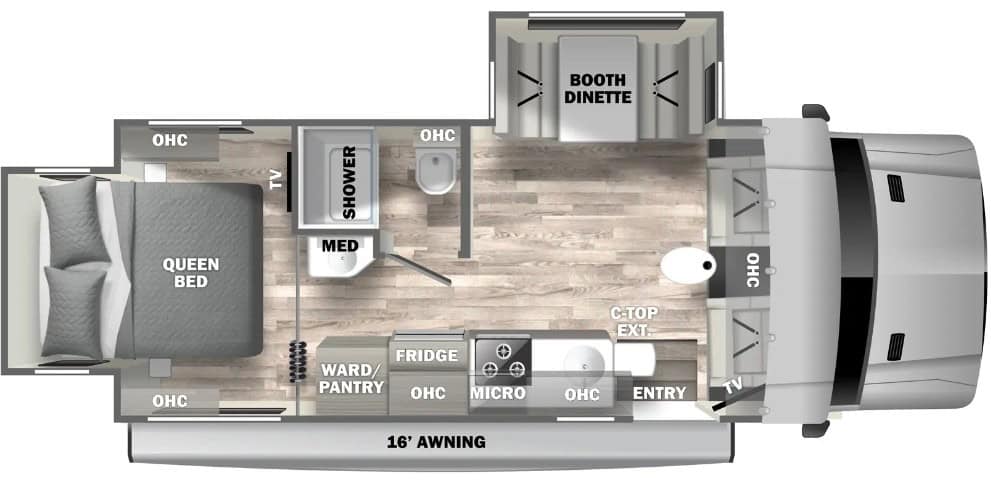
Despite its smaller size though, the Isata 3 24RW doesn’t compromise on features offering dual slides, a private rear bedroom with a walk-around queen bed, a fully equipped kitchen, and a full bathroom.
Plus, the 24RW is loaded with premium features including a custom full-body paint package, an armless patio awning with LED lighting, and a well-appointed interior featuring premium vinyl flooring, soft-touch padded vinyl ceiling, and hardwood craftsman-style cabinetry.
To learn more about the Dynamax Isata 3 24RW, check out Dynamax’s website by clicking here.
2. Entegra Qwest 24L: A Fuel-Efficient Luxury Class C RV
Quick Specs
- Average Price: $120,000
- Chassis: Mercedes-Benz Sprinter 3500
- Average Fuel Mileage: 18 MPG
- Length: 25′ 2″
- Sleeping Capacity: 2-6 (Depending on Options)
- Bathroom: Full 3-Piece Dry Bath
- Slide-Outs: 1 (Full Wall Slide)
The Entegra Qwest 24L is a Class C RV that offers an impressive average fuel economy of 18 MPG.
This fuel efficiency is achieved through its smaller size, Mercedes-Benz Sprinter 3500 chassis, and 2L V4 Twin Turbo diesel engine.
Despite its compact 25-foot length, the Qwest 24L doesn’t compromise on luxury or comfort.
Entegra Qwest 24L Floorplan
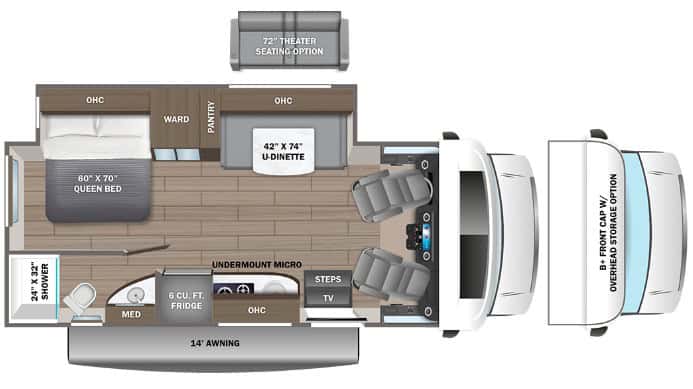
Offering numerous features that enhance both comfort and functionality. The Qwest 24L has a Firefly total coach control system with remote access via a mobile app, Tecnoform high-gloss cabinetry, a 10.25-inch integrated Mercedes-Benz infotainment center, and a Girard armless patio awning with LED light strip.
The RV also features a 200-watt solar panel and a Winegard Connect 2.0/4G antenna for off-grid capabilities.
To learn more about the Entegra Qwest 24L, check out Entegra’s website here.
3. Airstream Atlas 24MS: Ultimate Luxury Couples Coach
Quick Specs
- Average Price: $280,000
- Chassis: Mercedes-Benz Sprinter 4500
- Average Fuel Mileage: 17.5 MPG
- Length: 24′ 9″
- Sleeping Capacity: 2 (Power Sofa with Murphy Bed)
- Bathroom: Full Residential-style 3-Piece Dry Bath
- Slide-Outs: 1
The Airstream Atlas 24MS is a Class C RV that combines luxury with impressive fuel efficiency, offering an average of 17.5 MPG.
Built on the robust upgraded Mercedes-Benz Sprinter 4500 chassis, this touring coach is powered by a 2.0L turbocharged 4-cylinder high-output diesel engine, offering a perfect balance of power and fuel economy.
Beyond the turbo diesel, the Atlas also includes the advanced Mercedes-Benz powertrain, featuring BlueTEC SCR Technology and a 9G-TRONIC Plus transmission, which further enhances its fuel economy.
Airstream Atlas 24MS Floorplan
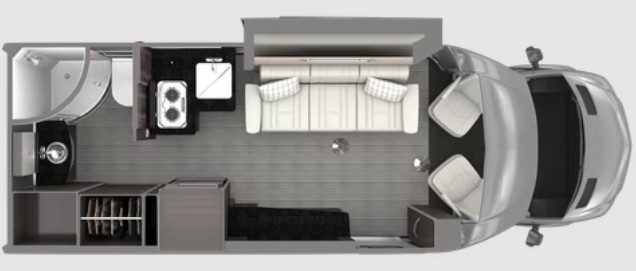
What the Airstream Atlas 24MS is really known for though is its unparalleled luxury, as you’d be hard-pressed to find a more premium luxury Class C on the market.
Designed to the be ultimate luxury couples coach, this fuel-efficient Class C RV from Airstream offers a power slide-out, a power sofa that converts to a Murphy bed, and a full residential-style bathroom.
Plus, the coach also offers a Multiplex Bluetooth App Control System, a 400-watt solar system, two 100 Ah lithium batteries, and a 3.6 kW LP generator for off-grid capabilities.
For more info on the Airstream Atlas 24MS, visit Airstream’s website here.
4. Winnebago View 24D: Compact Luxury with Impressive Fuel Efficiency
Quick Specs
- Average Price: $160,000
- Chassis: Mercedes-Benz Sprinter
- Average Fuel Mileage: 17 MPG
- Length: 25’6″
- Sleeping Capacity: 4-6 (Depending on Options)
- Bathroom: Rear 3-Pice Dry Bath
- Slide-Outs: 1 (Full Wall Slide)
The Winnebago View 24D is a well-designed Class C RV that combines luxury with impressive fuel efficiency, achieving an average of 17 MPG.
This motorhome is built on the premium Mercedes-Benz Sprinter Chassis and offers a perfect balance of comfort, functionality, and economy.
The Mercedes-Benz 3.0L 6-cylinder, 188-hp turbo-diesel engine is key to its fuel efficiency, along with its 7G-Tronic automatic transmission.
Winnebago View 24D Floorplan
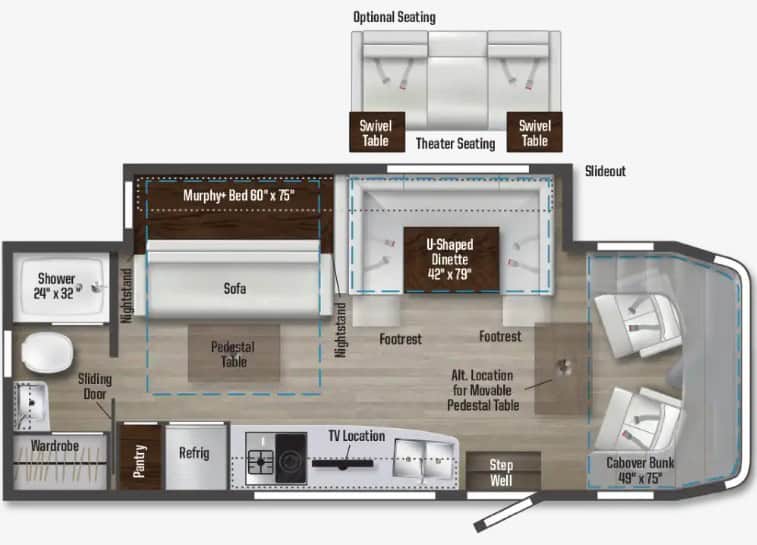
The View 24D maximizes its compact 25-foot 6-inch length with a well-laid-out floor plan. Featuring a plush U-shaped dinette with footrests that can convert into additional sleeping space, a sofa that transforms into a comfortable Murphy+ bed, and a spacious rear bath.
In addition, the single full wall slide-out in the living area significantly increases the interior space when the RV is in camp mode.
For more information on the Winnebago View 24D, visit Winnebago’s website here.
5. Coachmen Prism Select 24FS: Affordable Fuel-Efficient Class C
Quick Specs
- Average Price: $115,000
- Chassis: Mercedes-Benz Sprinter
- Average Fuel Mileage: 17 MPG
- Length: 25′ 2″
- Sleeping Capacity: 4-6 (Depending on Options)
- Bathroom: 3-Piece Dry Bath
- Slide-Outs: 1 (Full Wall Slide)
The Coachmen Prism Select 24FS is an affordable Class C motorhome built on the Mercedes-Benz Sprinter chassis.
Key to its efficiency is the Mercedes-Benz 4-cylinder diesel high-output engine paired with a 9G-TRONIC automatic transmission. This powertrain offers 208 horsepower and 322 pound-feet of torque, providing ample power while maintaining fuel efficiency.
Coachmen Prism Select 24FS Floorplan
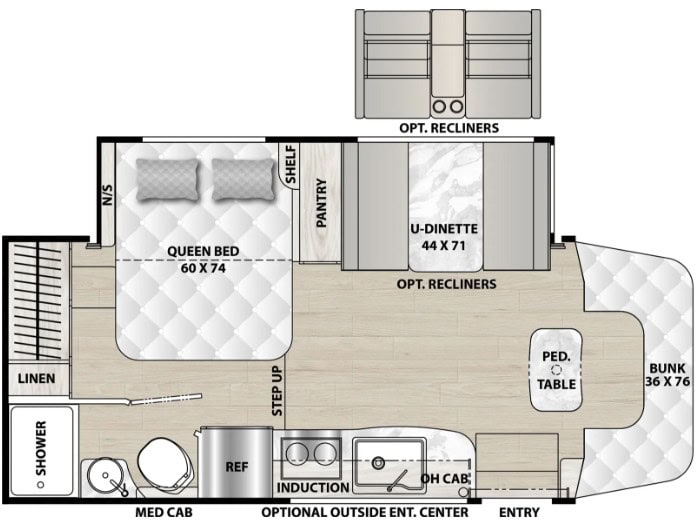
The Prism Select 24FS features a large slide-out that significantly increases the living space, a spacious dinette, a well-equipped kitchen, and a surprisingly roomy bathroom. The cabover bunk also adds additional sleeping capacity, making it suitable for families.
Overall, the efficient Mercedes diesel engine, aerodynamic design, and relatively compact size make the Prism Select 24FS one of the most fuel-efficient Class C RVs you can buy.
To learn more about the Coachmen Prism Select 24FS, check out Coachmen’s website here.
Class C RV Fuel Mileage FAQs
Additional Class C RV Resources:
- Why are Class C Motorhomes So Expensive? (Full Explanation)
- Leveling Jacks & Class C RVs: What You Need to Know
- How Wide is a Class C Motorhome? Know Before You Go
- Is a Class A or Class C RV Bigger? (20 Examples)
Recent Posts
When cruising down the highway in your RV, the last thing you want is a tire blowout! Not only is it dangerous, but RV tire replacement isn't cheap, costing $200 to $300 per tire. The good news,...
Nothing ruins an RV adventure faster than a breakdown with no way to fix it. Because of this, every RVer should have a well-stocked RV tool kit for those unexpected roadside emergencies and campsite...

